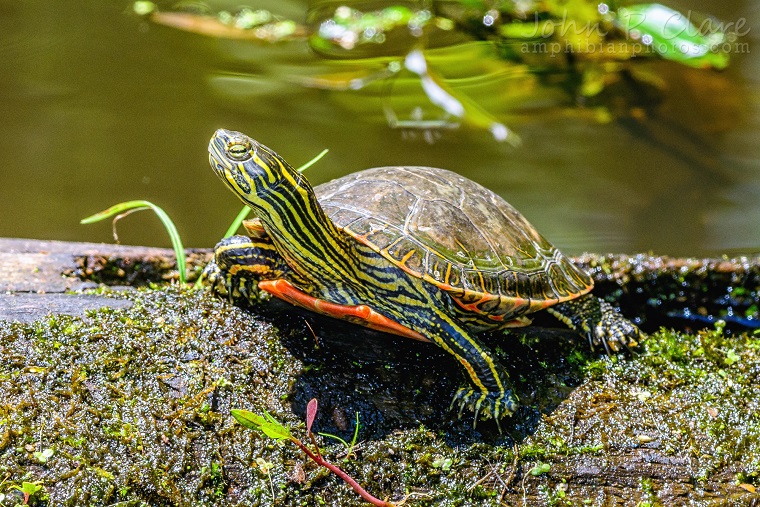Chilled out: How Turtles Survive in Frozen Ponds for Months Without Oxygen
By Olivia Balkwill
18 October 2021

A western painted turtle (image by John P. Clare, CC BY-NC-ND 2.0)
Anoxic (no oxygen) environments are usually deadly to animals, causing cell death that damages critical organs such as the heart. But there are exceptions to almost every rule in nature, and the western painted turtle (Chrysemys picta bellii) is the incredible exception when it comes to surviving without oxygen.
Adult turtles spend their winters at the bottom of frozen lakes, living for months at a time without oxygen.
“Painted turtles are champions among vertebrates in their ability to live without oxygen,” says Dr. Sarah Alderman, an adjunct professor in the Department of Integrative Biology who studies the effects of environmental stress on animal physiology.
But how is it possible for adult turtle hearts continue to beat without oxygen for so long? And why are the hearts of turtle hatchlings unable to survive in the same conditions as the adults?
Alderman and a group of colleagues from the Department of Integrative Biology and St. Louis University set out to answer these questions and found some surprising results.
The team suspected that as winter approaches, the chilly weather makes the turtles better at withstanding periods without oxygen. Therefore, they wanted to find out if a cold spell would trigger changes in the hearts of adult turtles that could make them work better in anoxia, preparing them for overwintering in lake bottoms. In contrast, they assumed that the hearts of hatchlings would undergo few, if any, of these changes, given that they spend the winter above ground where they can continue to get oxygen from the air.
To test their hypothesis, the researchers looked at how proteins in heart tissue changed following cold acclimation in both adults and hatchlings. Half the turtles in each age group were cold acclimated to 3 C, while the other half acclimated to 20 C (the control group). The researchers then harvested heart tissue from the turtles to characterize the protein composition.
The results were not quite what the team expected, however. It turns out that the life stage of the turtle has much more of an impact on the heart protein composition than the acclimation temperature.
Over 200 proteins changed as the turtles grew into adults. Many of these protein changes were associated with an increase in energy production that supported heart function. But there were very few changes to heart proteins caused by cold acclimation in either adult or hatchling hearts.
“These results show that turtles prioritize the growth and development of the heart even under environmental conditions that may impede heart function, because the heart is critical for survival,” explains Alderman.
The study highlights the importance of developmental stage on the ability of turtles to survive anoxia.
“Most of the previous research in this area focused on the effects of cold acclimation, but this research indicates that there is a lot to be learned about how maturation of the turtle contributes to anoxia tolerance.”
Studies like these, adds Alderman, “can help everyone build an appreciation for the natural world by better understanding the diversity of ways that animals overcome environmental challenges.”
But the results aren’t important only to turtle enthusiasts and animal physiologists - they could also have implications to human health. That’s because a heart attack also deprives heart tissue of oxygen.
“Understanding how a turtle’s heart can cycle in an out of these anoxic environments between seasons might offer new clues about what limits anoxia tolerance in human hearts. We might someday be able to apply this knowledge to help heart attack patients recover more effectively.”
This study was funded by the National Science Foundation.
Read the full study in the Journal of Experimental Biology.
Read about other CBS Research Highlights.